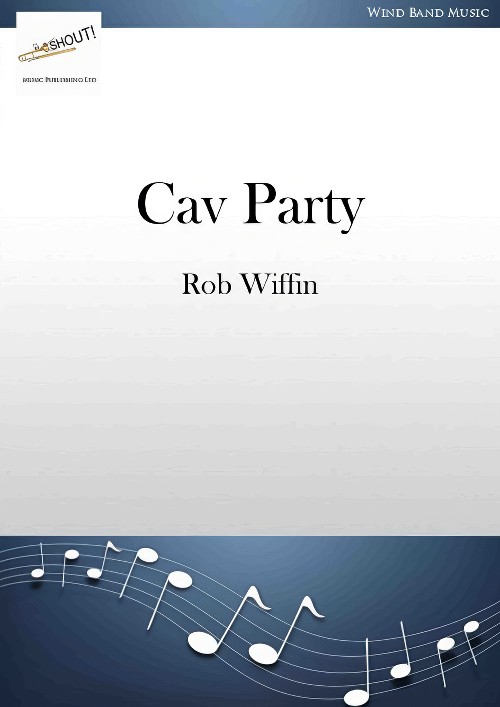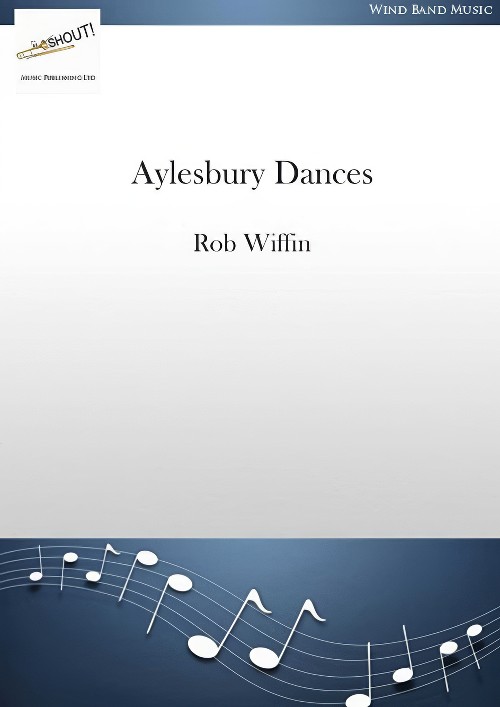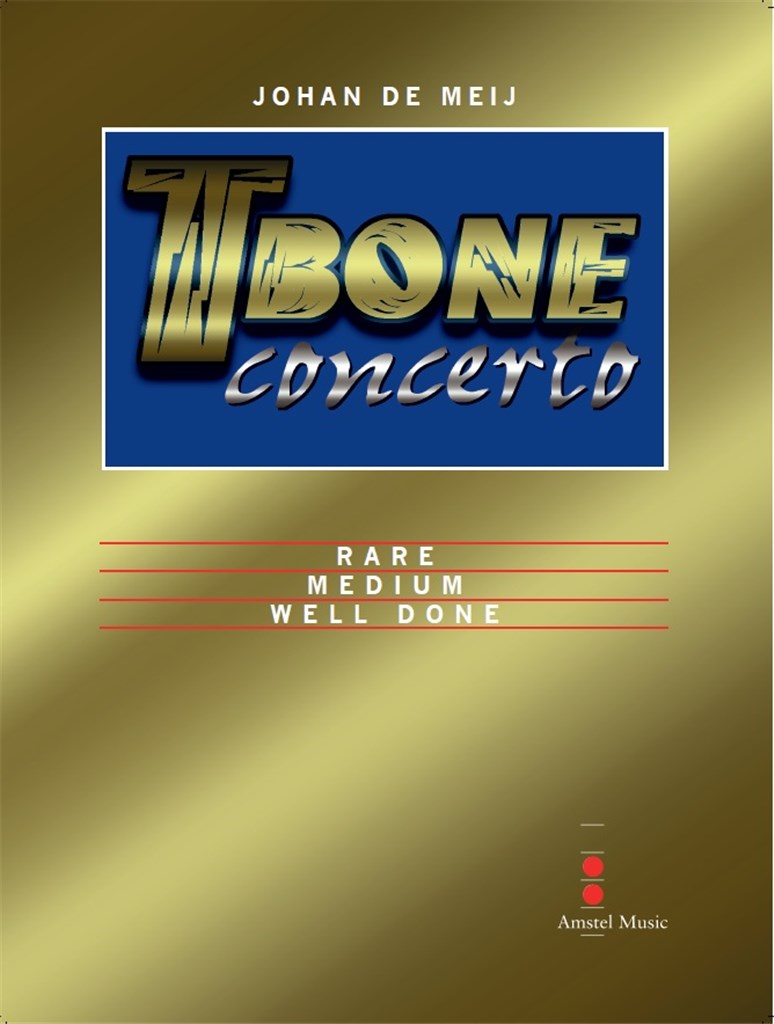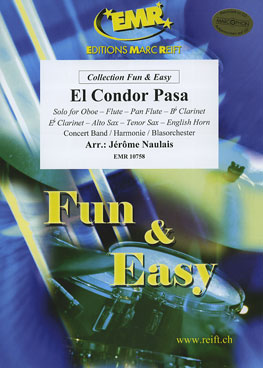Results
-
 £49.95
£49.95Cav Party (Concert Band - Score and Parts) - Wiffin, Rob
Cav Party was commissioned by The Band of the Household Cavalry in 2020. The idea was to showcase the various musical elements of the band in a party piece that gets more boisterous as it goes on. It utilises three Eighteenth century melodies associated with the band, starting off with a folkish setting of Handel's March from Scipio for harp, violin, flute and cor anglais (all fully cued on regular wind band instruments) and then into Keel Row where the accordion is featured before the whole band enters, and finally to Money Musk. Both Keel Row and Money Musk are played as Trot Marches by the band.The regimental slow march Scipio comes from Handel's opera of 1725 The Mercy of Scipio, which was based on the life of the Roman General Scipio Africanus.Keel Row is a traditional folk song evoking the life and work of the keelmen of Newcastle upon Tyne. It was first published in 1770, although it could be considerably older. The opening lines of the song describe Sandgate, the part of the quayside overlooking the River Tyne to the east of the city centre where the keelmen lived.Money Musk, also known as Monymusk or Monnymusk was originally a pipe tune composed by Scottish fiddler Daniel (sometimes Donald) Dow (1732 - 1783) in 1776. It takes its name from a baronial estate in Aberdeenshire, Scotland called Monymusk House. The tune first appeared in Dow's Thirty Seven New Reels, c. 1780 under the title Sir Archibald Grant of Monemusk's Reel.Duration: 3.45
Estimated dispatch 7-14 working days
-
 £69.95
£69.95Aylesbury Dances (Concert Band - Score and Parts) - Wiffin, Rob
The suite Aylesbury Dances was commissioned by the Aylesbury Concert Band to mark the occasion of their 25th Anniversary in 2019. Its three movements depict different aspects of Aylesbury: I. Pavane: The Town - Having read something of the town's history and its architecture I decided I wanted to write something ceremonial with the feel of music from Tudor times. Aylesbury was given its charter and borough status in 1554 by Mary Tudor so I took that as my starting point but then added some harmony that moves forward in time. This fits with the town's motto: Semper Prorsum (Always forward) and also with the Band's evolution from Aylesbury Town Band to Aylesbury Community Concert Band to Aylesbury Concert Band. The music can be defined as a pavane, or a cortege. The sense of procession is slightly disturbed by a 'Blue Leanie' moment. The Blue Leanie is an iconic Aylesbury building, an oblique rhombic prism which stands at an angle of 17% inclination. I took a quaver out of the time signature (I know the maths don't work!) to reflect this and added some bluer harmony at that point. This opening movement gives a sense of the grandeur and heritage of Aylesbury town and a chance for my friends from the brass section to warm up! II. Siciliana: Waterside - To balance the outer two movements, the middle movement of the suite has a slow lilting 6/8 rhythm. It is in the style of a Siciliana, a dance form originating in the baroque era. It is a graceful, tender and melancholic dance, cast here in a minor key and featuring the dark voice of the cor anglais. The Siciliana was often linked with pastoral scenes and Aylesbury itself sits amid some beautiful countryside. It may, therefore, seem a bit of a stretch to call this movement 'Waterside', especially as Aylesbury is so far from the sea, but the town has a theatre of that name and that was the genesis for this particular music. There is a statue of Ronnie Barker in the grounds of the Waterside theatre as he started his career in repertory theatre in Aylesbury, so I included a fleeting reference to the theme music of the comedy programme 'Open all Hours'. III. Frolic: Ducks in a Row - It was impossible to write a piece connected with Aylesbury without considering the famous Aylesbury ducks. Duck rearing was a major industry in the town in the 19th century. The white Aylesbury Duck is a symbol of the town, appearing on its coat of arms and in the logo of the Aylesbury Concert Band! This movement is all about trying to get the little darlings in a row so they can sing their 'Duck Chorus' together but they keep on scattering, flying off or swimming away as quickly as they can manage. It's a bit like watching ducks disperse when my dog jumps into the stream after them. Eventually we get more of them in a row - even though they protest. Hidden amongst the ducks is a reference to Erica Miller, saxophonist and chairman of the band, and there's even a veiled reference to a shark in the hope of getting them out of the water. Ducks in a Row is a fun romp bringing this suite of Aylesbury Dances to a suitably celebratory conclusion.- Rob Wiffin.Duration: 9.15
Estimated dispatch 7-14 working days
-
 £344.00
£344.00T-Bone Concerto (Trombone Solo with Concert Band - Score and Parts) - De Meij, Johan
The T-Bone Concerto was Johan de Meij's first composition for solo instrument and symphonic band. It consists of three movements called respectively 'Rare', 'Medium' and 'Well Done'. In addition to the solo trombone, an important role has been allotted to a kind of chamber music ensemble within the band. This group introduces new thematic material and accompanies the soloist, thus creating a delightful transparant accompaniment. The ensemble consists of a double wind quintet (2 flutes, 2 oboes, 2 clarinets, 2 french horns and 2 bassoons) plus a cor anglais and a double bass. Parts I and II are written in the A-B-A form and allow the soloist to display both the technical and the lyrical characteristics of the instrument. Part III at first develops into a kind of neo-baroque style using the thematic material of the first and second movement, and finally leads to a triumphant finale and a virtuoso conclusion. Duration: 25.00
Estimated dispatch 7-14 working days
-
 £111.00
£111.00Well Done (Movement III from T-Bone Concerto) (Trombone Solo with Concert Band - Score and Parts) - De Meij, Johan
The T-Bone Concerto was Johan de Meij's first composition for solo instrument and symphonic band. It consists of three movements called respectively 'Rare', 'Medium' and 'Well Done'. In addition to the solo trombone, an important role has been allotted to a kind of chamber music ensemble within the band. This group introduces new thematic material and accompanies the soloist, thus creating a delightful transparant accompaniment. The ensemble consists of a double wind quintet (2 flutes, 2 oboes, 2 clarinets, 2 french horns and 2 bassoons) plus a cor anglais and a double bass. Parts I and II are written in the A-B-A form and allow the soloist to display both the technical and the lyrical characteristics of the instrument. Part III at first develops into a kind of neo-baroque style using the thematic material of the first and second movement, and finally leads to a triumphant finale and a virtuoso conclusion. Duration: 6.15
Estimated dispatch 7-14 working days
-
 £111.00
£111.00Medium (Movement II from T-Bone Concerto) (Trombone Solo with Concert Band - Score and Parts) - De Meij, Johan
The T-Bone Concerto was Johan de Meij's first composition for solo instrument and symphonic band. It consists of three movements called respectively 'Rare', 'Medium' and 'Well Done'. In addition to the solo trombone, an important role has been allotted to a kind of chamber music ensemble within the band. This group introduces new thematic material and accompanies the soloist, thus creating a delightful transparant accompaniment. The ensemble consists of a double wind quintet (2 flutes, 2 oboes, 2 clarinets, 2 french horns and 2 bassoons) plus a cor anglais and a double bass. Parts I and II are written in the A-B-A form and allow the soloist to display both the technical and the lyrical characteristics of the instrument. Part III at first develops into a kind of neo-baroque style using the thematic material of the first and second movement, and finally leads to a triumphant finale and a virtuoso conclusion. Duration: 8.30
Estimated dispatch 7-14 working days
-
 £111.00
£111.00Rare (Movement I from T-Bone Concerto) (Trombone Solo with Concert Band - Score and Parts) - De Meij, Johan
The T-Bone Concerto was Johan de Meij's first composition for solo instrument and symphonic band. It consists of three movements called respectively 'Rare', 'Medium' and 'Well Done'. In addition to the solo trombone, an important role has been allotted to a kind of chamber music ensemble within the band. This group introduces new thematic material and accompanies the soloist, thus creating a delightful transparant accompaniment. The ensemble consists of a double wind quintet (2 flutes, 2 oboes, 2 clarinets, 2 french horns and 2 bassoons) plus a cor anglais and a double bass. Parts I and II are written in the A-B-A form and allow the soloist to display both the technical and the lyrical characteristics of the instrument. Part III at first develops into a kind of neo-baroque style using the thematic material of the first and second movement, and finally leads to a triumphant finale and a virtuoso conclusion. Duration: 10.30
Estimated dispatch 7-14 working days
-
 £100.00
£100.00EL CONDOR PASA (Flexible Solo with Easy Concert Band) - Naulais, Jerome
Solo for Oboe, Flute, Pan Flute, Bb Clarinet, Eb Clarinet, Alto Sax, Tenor Sax or Cor Anglais. Duration: 4:15
Estimated dispatch 7-14 working days
-
£174.99
Excelsior Wind Band Set (Score & Parts)
Excelsior was composed by Rob Goorhuis in the year 2000 on the occasion of the 75th anniversary in 2001 of the Amsterdam-based concert-band Jong Excelsior. Excelsior is a one-movement fantasia, consisting of contrasting themes. The first theme (the Excelsior theme) is characterized by angular figures moving in an upward direction. The second theme is playful and humorous in nature. Rob Goorhuis, who was born and bred in Amsterdan, may even have utilized memories of his own juvenile pranks in this second theme. The third theme, which is introduced by the cor anglais is melancholy and melodious. The elements mentioned above interchange in a thoroughly captivating manner, which ultimately results in an attractive composition fully capable of adding lustre to an anniversary. Excelsior werd door Rob Goorhuis gecomponeerd ter gelegenheid van het 75-jarig jubileum van muziekvereniging Jong Excelsior te Amsterdam. Excelsior is een doorgecomponeerde fantasie, bestaande uit met elkaar contrasterende themas. Het eerste (Excelsior)thema wordt gekenmerkt door hoekige stijgende figuren. Het tweede thema is speels en humoristisch van karakter. Rob Goorhuis, geboren en getogen Amsterdammer, verwerkte hierin wellicht herinneringen aan de kwajongensstreken uit zijn jeugd in Amsterdam. Het derde thema, ge?ntroduceerd door de Engelse hoorn, is melancholiek en zangerig. Genoemde elementen wisselen elkaar op boeiende wijze af, zodat een attractieve compositie is ontstaan. Dit werk is opgenomen in het Klein repertorium, harmonie - 1e divisie 12:00
Estimated dispatch 7-14 working days
-
 £140.00
£140.00GALLIMAUFRY (Concert Band) - Woolfenden, Guy
Gallimaufry (gali maw'fri): A medley; any confused jumble of things; but strictly speaking, a hotch potch made up of all the scraps of the larder. cf Shakespeare: The Winter's Tale: "a gallimaufry of gambols"I. Church and StateII. Inn and OutIII. Starts and FitsIV. Father and SonV. Advance and RetreatVI. Church and Status QuoGallimaufry was inspired by Shakespeare's Henry IV plays, and derives from music I composed for the Royal Shakespeare Company's production which opened the Barbican Theatre in 1982. The score is dedicated to Trevor Nunn, then Artistic Director of the RSC, with grateful thanks for his suggestion that I should expand and mould the music from these productions into a form suitable for concert performance.My thanks also to Timothy Reynish and the British Association of Symphonic Bands and Wind Ensembles who, with funds provided by North West Arts, commissioned the work and helped to ensure its first performance on September 24th 1983 with the Royal Northern College of Music Wind Orchestra.The work is continuous and the thematic material of each of the six sections closely related. The "establishment" - leadership, temporal and ecclesiastical power - are depicted in the stately march which opens the work. (Church and State)The second section, Inn and Out, in an energetic hemiola rhythm, is concerned with the stews and low-life revels at the Boar's Head Tavern. This is interrupted and finally integrated with the Tavern Brawl and Gadshill Ambush of Starts and Fits.The mood changes and the ambivalence of Prince Hal's relationship with his father and surrogate father, Falstaff, is portrayed in a serene cor anglais solo. (Father and Son)Advance and Retreat is a recruiting march, derived from the Tavern Tune and leads into the last movement, Church and Status Quo, which deals with the rejection of Falstaff and the crowning of Price Hal. Order is restored with a majestic affirmation of the opening material.
Estimated dispatch 7-14 working days
-
£174.99
The Legend of Flathead Lake Wind Band Set (Score & Parts)
In Scotland, the monster of Loch Ness is a hot issue, but the American state of Montana enjoys a comparable phenomenon going by the name of Montana Nessie. In the western part of this remote state lies Flathead Lake: a lake of 45 kilometres /38 miles in lenght and 24 kilometres /15 miles breath. At several places, its depth exeeds 100 metres.Nessies discovery takes us back to the year 1889, when captain James Kerr aboard the passengership U.S.Grant was startled by a ship unknown to him suddenly approaching his vessel across Flathead Lake. However, it turned out not to be a ship but an undefinable animal of immense size.From that moment onwards, life would never be the same again in and around Flathead Lake.The composer was inspired by the story, and summarized the events into a symphonic poem, but from a surprising angle:that of the monster. The exiting opening allows us to follow the monster in its natural surroundings.The fast follow-up movement depicts Montana Nessie trotting and frolicking about the Montana woods and prairies.From its abode, it thorougly enjoys everything around it. This period abruptly ends in a short climax (Chimes). The solo for cor anglais marks a new period in the monsters life.The presence of people has a paralizing effect and the apprehensive atmosphere of the slow movement may be felt profoundly.The monster observes and mildly teases the ship. Abhor sounds force the ship to a withdrawal.The moving musical continuation depicts the triumphant monster dancing an ironic waltz. The monsters fear and anger at the intrusion of his freedom run through the piece like continuous threads, and develop into the works final theme. 12:00
Estimated dispatch 7-14 working days
